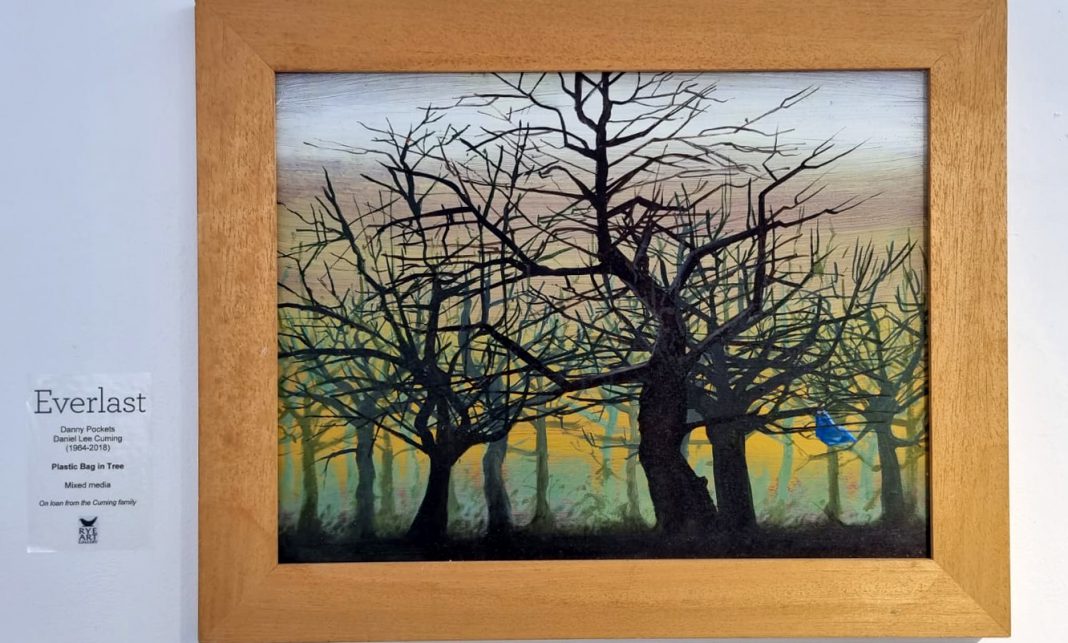Beauty in broken things is what only an artist with a grasp on life can find. In case you have missed this Retrospective Everlast, please do catch it before May 8. It is a must for every local art lover.
Art for art’s sake can create fake impressions of brilliance. None of that here. Daniel Lee Cuming has all the splendour of colour and the ability to draw texture from his use of the extraordinary in ordinary materials like used tea cartons. He also created an alter-ego for himself as a way to filter pain, Lego-Head and Lego Face Jonson. His almost casually pencil scratchings caroused on well-produced postcards tell a tale of torment. The artist at war with his materials, his process, his passion. Rarely do we get insights into how an artist evolves and comes of age until we get to witness their life’s work in one space. Having lost this exceptional creator of colour too soon, we can only imagine what more was to come.
Among a field of resplendent magenta foxgloves in June, I met Danny once. He was attending the annual birthday festivities of our common friend, painter Lincoln Taber. Lincoln and partner Susan have loaned their wedding gift from Danny for this exhibit. Danny’s scarlet, short-sleeved shirt and his laugh are what I recall best from that brief conversation. I cannot claim to have known his art before, but now, having walked through sunlit rooms where he speaks from almost every wall, I feel I know the artist. That is art, when brushstrokes blur time and the onlooker is where the painter-producer takes you. Whether a fragrant swish with an early Monet-esque Violet Flower (2000) or his captivating reimagining of Brighton Pier or Hoxton’s infamous Victory Café (2013) (mixed media on linen) signage or a virulent poster for Godspell you breathe it all in. Danny Pockets is alive in the colour of his living dreams.
His antecedents are immense. Fred Cuming (RA) sat among his son’s art with a glisten in his eye, which was hard for onlookers to bear, but harder still to experience for a man both proud and in pain. His pride at being hung within the same space, as his boy’s works was palpable, recounts Julian Day, curator of this spellbinding retrospective. This is no place to compare the work of father and son, sufficeth to say their flourishes are distinctly different. Clearly bred in an artistic playground, with a deep veined influence for the political as well as the playful, Danny Pockets blares alive with colours that would vibrate to an Indian summer. There is both movement and colour here, pain and memorialising splayed out on massive re-used doors doubling as canvases, or textured oils combing patched card-boxes into a homogenised whole for the onlooker to contemplate the position of the world we live in. His childlike brushed linear Marching Figures (1969) appears alongside his evolved newer work.
Comparisons in the artists’ world can feel like an insult. David Hockney and Andy Warhol might float to mind, but stop. Comparisons? However, in the art world an artist’s influences are always sought. What context was a particular work produced in? Historically, art speaks to the period in which it is created. Tamara de Lempicka’s work resonates with both her passions and the art nouveau context they are produced in. Danny Pockets’ speaks of a fragmented world. Both interior and otherwise. His multidimensional use of mediums other than a mere canvas speak to that fragmentation. His disillusionment with being categorised is explicit in this retrospective collection. Fragments are far from what he has bequeathed.
Louise Simkiss-Day, in her academic yet personal foreword to his brochure, expresses the onlookers viewpoint, what more would this mind have produced? Everlast is a curious but apt name for this collection. It brings home the poignant point that this is a truncated life in artistic terms. It is clearly a productive one, still full of the promise of discovery and new research to place this local artist in his proper place on the shelf of art history, alongside his progenitor. Brought together for the first time we can see pieces from the private collection of the artist’s family and friends on loan to complete our sense of this man who will now always speak through his brushwork. Phantasmagorical Pockets speaks with a voice that cannot, and should not be ignored.
The piece I was most spellbound by was the artist’s environmental statement, a lone belligerent blue plastic bag afloat in a sea of bare twigs on a bold, strong standing tree. This piece, on loan from the family, would ordinarily never have been available to audiences. I left feeling privileged.
Image Credits: Anwesha Arya .



